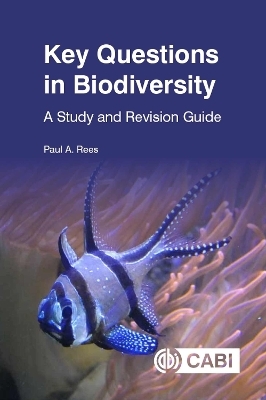
Key Questions in Biodiversity
CABI Publishing (Verlag)
978-1-78924-863-0 (ISBN)
An understanding of biodiversity is an important requirement of a wide range of programmes of study including biology, zoology, wildlife conservation and environmental science. This book is a study and revision guide for students following such programmes in which biodiversity is an important component. It contains 600 multiple-choice questions (and answers) set at three levels - foundation, intermediate and advanced - and grouped into 10 major topic areas: 1. Principles of classification and taxonomy 2. Comparative anatomy and physiology 3. Protoctists, monerans, fungi, lichens and acellular organisms 4. 'Lower' plants and pteridophytes 5. Seed-bearing plants 6. Sponges, cnidarians, nematodes and minor animal phyla 7. Platyhelminths, annelids and molluscs 8. Arthropods and echinoderms 9. Fishes, amphibians and reptiles 10. Birds and mammals The book has been produced in a convenient format so that it can be used at any time in any place. It allows the reader to learn and revise the meaning of terms used in animal and plant classification, the principles of comparative physiology, and the characteristics of, and diversity in, the major animal and plant taxa. The structure of the book allows the study of one topic area or group of taxa at a time, progressing through simple questions to those that are more demanding. Many of the questions require students to use their knowledge to identify organisms and biological structures from drawings or photographs.
Paul Rees was a senior lecturer in the School of Science, Engineering and Environment at the University of Salford, United Kingdom, for 22 years until his retirement in 2020. He holds a BSc in Environmental Biology from the University of Liverpool and a PhD in animal ecology and behaviour from the University of Bradford. Paul previously lectured at three Further Education Colleges and a Higher Education College in the United Kingdom, and trained biology teachers at Sokoto College of Education in Nigeria. He has taught from GCE 'O'/GCSE level to MSc level and has been an external examiner for a range of taught programmes, from Higher National Diploma to MSc level, at six British universities. Paul has published papers on mammal behaviour and ecology, wildlife law, and the role of zoos in conservation, along with eight textbooks concerned with ecology, zoo biology, wildlife law and elephants. He is the author of Key Questions in Ecology: A Study and Revision Guide and Key Questions in Applied Ecology and Conservation: A Study and Revision Guide.
1: Principles of classification and taxonomy 2: Comparative anatomy and physiology 3: Protoctists, monerans, fungi, lichens and acellular organisms 4: ‘Lower’ plants and pteridophytes 5: Seed-bearing plants 6: Sponges, cnidarians, nematodes and minor animal phyla 7: Platyhelminths, annelids and molluscs 8: Arthropods and echinoderms 9: Fishes, amphibians and reptiles 10: Birds and mammals
| Erscheinungsdatum | 18.05.2021 |
|---|---|
| Reihe/Serie | Key Questions |
| Verlagsort | Wallingford |
| Sprache | englisch |
| Maße | 156 x 234 mm |
| Gewicht | 492 g |
| Themenwelt | Naturwissenschaften ► Biologie ► Ökologie / Naturschutz |
| Naturwissenschaften ► Biologie ► Zoologie | |
| ISBN-10 | 1-78924-863-9 / 1789248639 |
| ISBN-13 | 978-1-78924-863-0 / 9781789248630 |
| Zustand | Neuware |
| Informationen gemäß Produktsicherheitsverordnung (GPSR) | |
| Haben Sie eine Frage zum Produkt? |
aus dem Bereich


